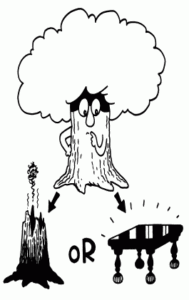
Every organization must reckon with “old-timers”: staff who have served many years but may be past their most productive prime.
What should you do with these folks?
Firing them seems a mercenary way to run a business. But keeping them on staff can demotivate and demoralize others, increasing your payroll without improving profits.
A journalist recently asked me point-blank, “What should companies do with their ‘dead wood’?”
My answer was a question; “Is the ‘dead wood’ raw material for valuable antiques, or is it dangerous rot?” Can they serve to improve customer experience or do they detract from it?
Many long-serving staff have a wealth of experience, customer knowledge and good ideas to improve customer experience. They can be valuable in training new staff, contacting and caring for customers, spreading goodwill for the company through public relations or community outreach programs. In short, they can improve customer experience by remaining on staff.
Long-serving staff may not be able to master the latest technology or move at the current pace of change, but their knowledge and proven skills could still be harnessed for the benefit of all. These team members are raw material for creating treasured and high-value antiques.
One large company offered senior staff an option of retiring early or working in new capacities as recruiters, staff trainers or customer service personnel, working to improve customer experience. Each of these positions offered a lower level of salary but recognized and leveraged the staff members’ years of experience. Half of those offered the new positions stayed on, adding new value to the organization. The other half moved on.
Another company offered no salary at all, but provided office facilities and a generous incentive program so that older staff could contact former customers to help stimulate or reactivate their accounts in an effort to bring back business and improve customer experience.
The success rate was tremendous and it did serve to improve customer experience.
Each conversation brought together a long-serving staff member with a long-standing (but no longer active) customer. Rapport was easily established as both sides shared experiences and insights about the company, its services and products. Many of these heart-to-heart conversations resulted in reactivation of accounts, new purchases, new profits and plenty of new ideas for the company to improve customer experience.
From old wood came precious antiques that were a treasure trove to improve customer experience.
But what about long-serving staff who have become cynical, resentful and demoralized? What about those who speak badly about the company and complain openly to customers and other staff?
These employees are toxic and contagious and do nothing to improve customer experience. They are the unhealthy rot that can destroy the competitiveness and the culture of your organization. Such “rotten apples” should be excised as quickly and cleanly as possible. To keep them around through some misguided interpretation of loyalty is sheer lunacy and will not improve customer experience.
If someone is earning money from an organization, they owe their active loyalty to the current health and future well-being of that organization – period.
Two points to note: (warning – may be controversial)
1. The commercial world is changing too fast for inflexible employment entitlements. Union agreements that arrest or retard an industry’s ability to innovate are doing an injustice to the industry, the companies and the countries in which they work. Short-term gains for a few may result in long-term losses for everyone.
2. Everyone in an organization should add value or be released. Pay should be based on value contributed to the organization in current time – not on continuous recognition of value generated in the past. Stagnation does not improve customer experience or profits.
Old-timers may not be able to generate the same amount of sales value or productivity as before, and their compensation could be adjusted accordingly.
But given the option of working in new ways, creating new value and earning a new (sometimes lower) income, many staff will choose that route over leaving employment altogether.
Key Learning Point To Improve Customer Experience
As the population and workforce age, many companies can benefit by taking an innovative approach to keeping their long-serving members on staff. This plan for creating and delivering new value should be initiated early so that old wood can be transformed into beautiful and valuable antiques…before it rots.
Action Steps To Improve Customer Experience
Review how your organization currently harnesses the experience of your longest-serving staff. Create a focus group of current and former employees, customers and suppliers to brainstorm together. Find new ways for old-timers to create new value for the future and to help improve customer experience.
——————————————————————————————————————————
You may use this article in your free newsletter, website or publication providing you include this complete statement (below) with active links to the websites:
Copyright, Ron Kaufman. Used with permission. Ron Kaufman is the world’s leading educator and motivator for upgrading customer service and uplifting service culture. He is author of the bestselling “Uplifting Service” book and founder of Uplifting Service. To enjoy more customer service training and service culture articles, visit www.RonKaufman.com.
For commercial use of this article in a paid newsletter, publication, or training program, please contact us.



